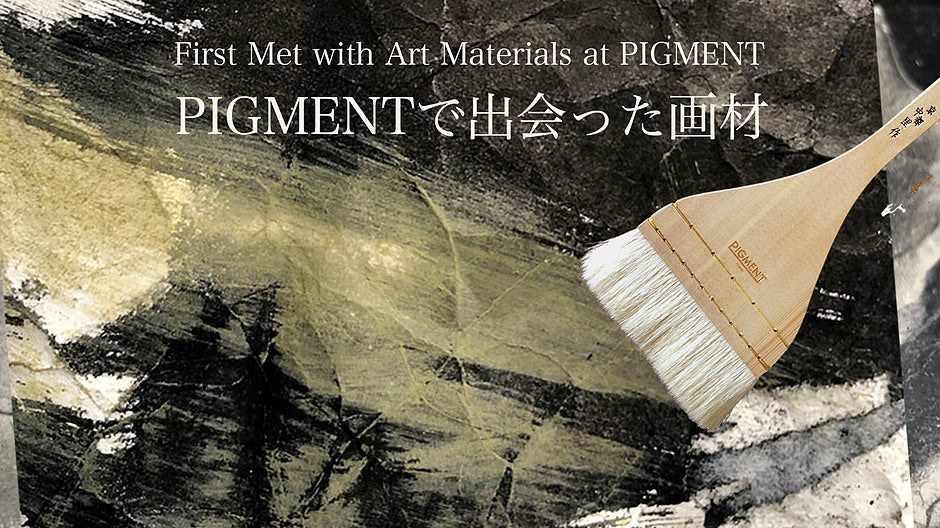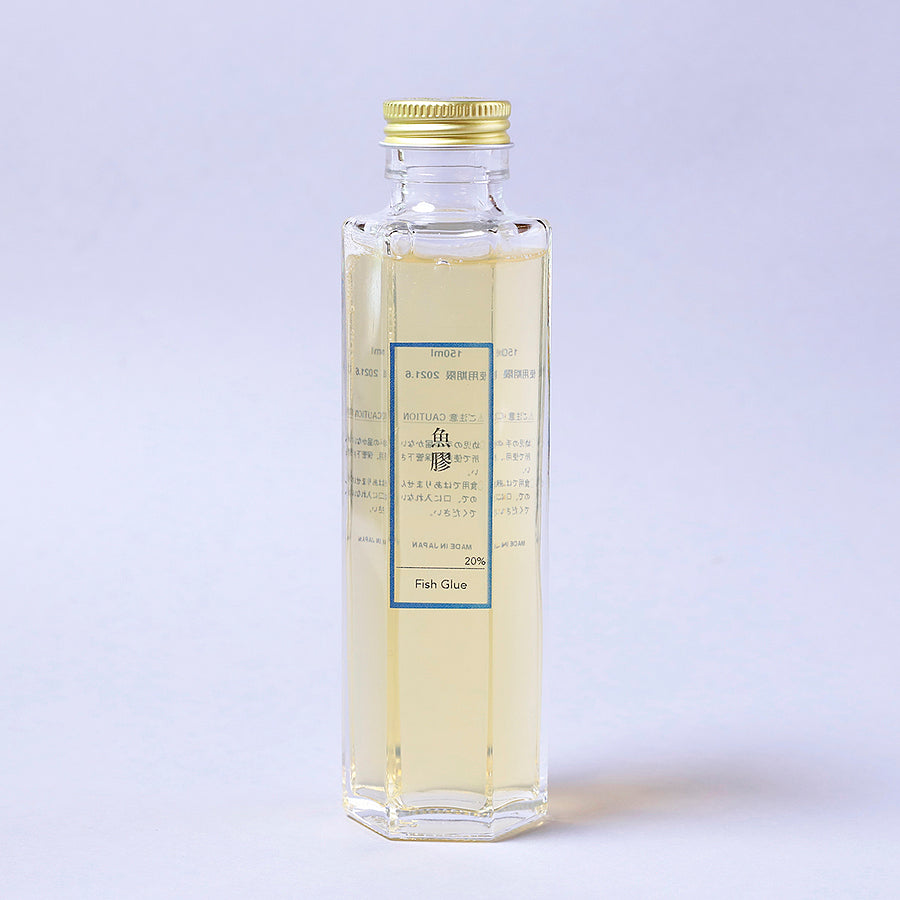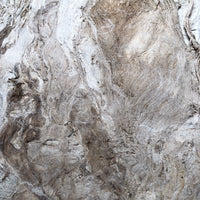Are there any art materials that you have recently discovered for the first time?
When I first joined PIGMENT TOKYO as a staff this spring, I was very excited to see how much more I could take in.
Up until now, I have been making works using paper, ink and natural pigments, as well as doing simple Dosa sizing (technique for preventing color bleeds), so I was familiar with Sumi ink, Washi (Japanese paper), Nikawa (animal glue) and brushes. However, I was always keenly aware that there was still a lot I didn't know.
I decided to join PIGMENT TOKYO partly because of my desire of wanting to explore the tools and materials I’ve been using, and also to broaden my range of creativity by acquiring a deeper knowledge of art materials.
Each person has their own way of expressing in arts, even if they are using the same art materials.
I would like to introduce some of the materials that I actually bought and used, some of which I knew about but didn't know exactly how to use, and some of which I had never heard of before.
Personally, the art material I am most interested in and want to know more about, the first thing that comes to my mind is the Nikawa (animal glue)!
There was a period of time when the shops were closed due to the coronavirus, and while I was working on my drawing, I was at home watching PIGMENT TOKYO’s live on Instagram about animal glue and I couldn’t stop thinking about it.
【IG LIVE】Animal Glue(English translations included)
https://www.instagram.com/tv/B_hDsZVnSJP/?igshid=5hx9hgnqnzyf
In this video, you can learn more about the animal glue we carry at PIGMENT TOKYO and what each glue is commonly used for. Moreover, for those who are unable to visit the store in person, our staff will be showing you around the display section of some rare and valuable animal glue in our Instagram live feed.
Some animal glues are not often found in other art stores, such as glue that is made of cow, deer, rabbit and fish. Animal glue is a type of gelatin that is extracted from the skin and bones of animals, which the color and jelly strength of the glue might be different depending on the raw materials.
The fact that the strength of the jelly differs from one lot to another, and therefore the use of the jelly changes is also very interesting for a natural medium.
The animal glue I chose was fish glue for Dosa sizing, and deer glue as a starchy binder for mineral pigments.
Cow, rabbit, deer, and fish glue can all be used as the binder. However, I chose deer glue because I had never used it before and I wanted to create a slightly deeper color in my drawing.
Certain fish glue can also be used as a binder depending on the strength of the jelly.

This is the deerskin glue that I bought.There are several different colors and shapes even for the same glue.
I was fascinated by their beautiful yellowish color and the interesting shapes.
※Color and shape of the glue differs according to the lot
I used to make only the amount of glue that I could use up, but after buying the fungicide (preservative), now I can make it into bottles and store it in the refrigerator for a long time.
By adding 0.1% of fungicide to the animal glue, it can be used safely without affecting the color and storage. This is highly recommended for those who are making their own glue.
For those who are interested in making the animal glue, here's a video to help you get started!
PIGMENT Channel - Making Animal Glue
Dosa sizing is a Japanese painting technique that is commonly used to stop the bleeding of the colors while using Japanese paper or painting silk.
If you draw on a raw Japanese paper that has not been Dosa-sized, the paper absorbs moisture and the color blurs, which is why most of the people either buy a Dosa-sized Washi or apply the Dosa themselves before using the paper.
Generally, Dosa is made by boiling Alum and animal glue in hot water, however the fish glue that shows below, you can use it for Dosa sizing directly without adding any Alum.
Since it also becomes a factor of the deterioration and the discoloration of Japanese paper by adding Alum. This is the reason why I am glad about the fact that Dosa sizing can be done by using only glue.
Since I wanted to experiment with different kinds and densities of animal glue, as well as the type of Japanese paper I use varies from time to time and the amount of glue required, I usually made my own glue. However, if you are a first time user or just want to use it casually, how about starting with a pre-made animal glue?
Furthermore, speaking of PIGMENT TOKYO, we have a collection of about 4,500 pigments on the display wall.
I'm sure many of you may have seen it in the store or know it from Instagram or our official website.
There are all kinds of pigments, such as natural and artificial mineral pigments, earth pigments, Suihi (tinted pigments), effect pigments etc.
You can choose from a variety of colors, types of pigments that you prefer, glossiness, etc., and I know sometimes it can be a little overwhelming by having this many choices. However, don’t you worry because there’s no correct answer for how you select your own pigment!

I chose earth pigments as my drawing material.
I have been using anthocyanin pigments and natural dyes for a while, and I have been interested in earth pigments and mordant dyes on Japanese paper that are made of clay, this is why I decided to apply some earth pigments on my recent work.

There are various types of earth pigments, not only from Japan, but also can be found in Germany, Italy, Russia, Morocco and China.
The pigments from the middle of the image above are the earth pigments. They are mostly calm, soft colors of brown, yellow, green and milky white.
When choosing the earth pigment of a place I have visited, it reminds me of the good memories about that place, and when choosing the earth pigments of an unfamiliar place, I would try to imagine the landscape and scenery. This is also a fun way to find new pigments that are different from other drawing materials.

These earth pigments are made from a selection of high quality natural soils, refined and then dried naturally in the form of plates, and is considerably harder than other pigments. For this reason, they have to be well grinded in a mortar before use.
I tried to use a grayish hue in combination with Sumi ink, so I chose "Italian Green Earth" which also has a blue tinge to it.

Since I wanted to give it a rough, earthy texture in my drawing, I made it a little rougher while grinding the earth pigment.
Each pigment has a different hardness, but if you prefer a smoother texture, make sure you grind it thoroughly.
However, these powder-like earth pigments won't stick together as paint alone, so they need to apply with a binder. This requires the use of a glue, also known as a medium.
In order to use the traditional Japanese technique and because it is more ideal for the Washi , I chose animal glue, but you can also make earth pigments into paints with other mediums too.
PIGMENT Channel - How to dissolve mineral pigments
This is an actual drawing painted with animal glue and earth pigments.

Left side of the painting : Before starting to draw, I applied a thick Dosa sized on the left part of the paper, which is why the ink doesn’t bleed or blur off, and you can clearly see the lines of brush strokes.
Right side of the painting : Earth pigment is drawn with a brush.
The magic of making your own paints, animal glue and Dosa is that you can adjust them according to the raw materials, the type of Washi and the way of your artistic expression.
More lectures and tutorials are now available on PIGMENT TOKYO’s Instagram live videos!
PIGMENT TOKYO goes on Instagram live once a week, and there will be two art experts introducing art materials. If you have any questions, feel free to ask them through the comment section, they will answer you in both Japanese and English on-time.
If you missed Instagram live, you can watch it later on IGTV.
PIGMENT TOKYO InstagramIGTV https://www.instagram.com/pigment_tokyo/channel/
PIGMENT Channel https://pigment.tokyo/en/blogs/pigmentchannel/
I still get butterflies when discovering new painting tools or art materials, and I keep wondering what I can do with them.
In the future, I will continue to explore art materials while being open to all kinds of possibilities.
I hope this article will help you to have more fun in drawing and creating!









